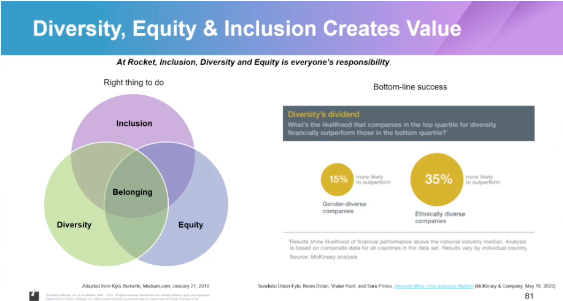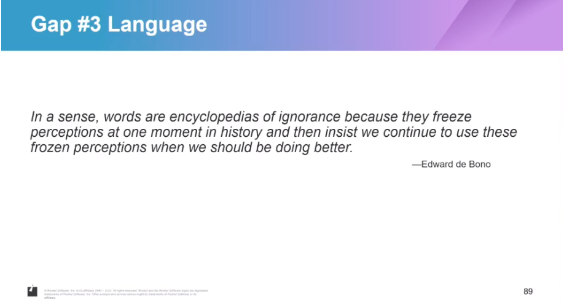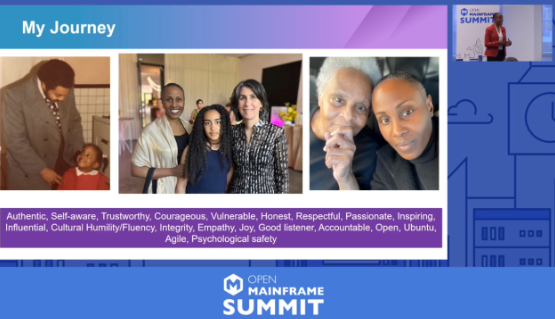Diversity, Equity and Inclusion (DEI) is rooted in the Open Mainframe Project culture – from leadership to project communities and everything in between. It’s no surprise that DEI was front and center at Open Mainframe Summit, hosted on September 21-22 in Philadelphia, PA and virtually.
Sharra Owens-Schwartz, Vice President of Inclusion, Diversity & Equity at Rocket Software, was at the Summit and gave a keynote about how DEI can create value, especially in the mainframe industry. Watch the video below or continue reading a summary of her presentation that highlights some of the personal details she shared.
A Personal Journey Toward a Passion for DEI
When hearing “diversity and inclusion,” a lot of people may feel like they want to run and hide. It is something that many misunderstand—or they don’t understand why it’s so important.
Sharra’s mother was critical in developing her into a person who understands and has a passion for DEI. Her dad was also an inspiration to her. He was the first African-American State Senator in Massachusetts, and she witnessed first-hand how influential he was in the community – breaking down barriers and opening up opportunities. He always made an effort to include folks, especially those traditionally excluded. He was authentic, inspiring Sharra to be who she is today: breaking down barriers for marginalized people and being authentic.
Defining DEI
Diversity deals with facts, like “I am a woman” and “I am black.” These are facts. But equity is a choice. It’s how you choose to interact with others and include or exclude those around you. Inclusion, the third element of DEI, is the breaking down of barriers. It means creating equity between your majorities and your minorities.
All this combines to create belonging. Belonging is the outcome we are aiming for.
Creating Value
Many companies say “we need to be more inclusive.” But they can stumble in understanding the importance of driving towards belonging.

Not only is pursuing DEI the right thing to do, but it also provides bottom-line success. Ethnically and racially diverse companies are 35% more likely to outperform, and gender-diverse ones are 15% more likely to outperform.
A key to leveraging this potential is to create equity. Focus first on providing equal treatment and opportunity among various demographics in your company.
Overall, DEI is good for mainframe organizations because it:
- is the right thing to do,
- creates a sense of belonging,
- encourages innovation and engagement, and
- increases your bottom line.
Bridging Gaps
Three main gaps inhibit DEI.
Power Gap
First is the power gap, and wage disparity is a large concern. That’s especially true in the C-suite, where white men are overrepresented compared to other roles in an organization. Women of color are represented as little as 4% in an organization’s C-suite!
This often happens because of a “broken ladder.” Women are not being promoted to the first level of management. The first rung of the ladder is not in place for them to climb. And there tends to be an informal sponsorship and network that men have access to and women don’t, even though they are half of the population.
To bridge the gap, we have to look at the data and share it. This is not the job of women alone. Men and women together must understand things like why certain people are always given stretch projects.
Black Women Gap
As the second gap, Black women are some of the most marginalized people in the United States. They make up about 64% of bachelor’s degrees. Oftentimes companies say “the talent isn’t there,” but the data from universities show otherwise.
We can bridge this gap by opening up our network. Check your biases. Oftentimes our biases are not even conscious, and we need to make them conscious. Become aware of how you are thinking about candidates and team members. Stretch yourself: reach out into networks you normally wouldn’t.
Language Gap
The third gap is language. We must stop using the word “diverse” when talking about an individual.

Words can freeze perceptions at a certain point in history. That’s because the words we use represent the thinking we had when the word became popular. “Diverse” is one of these words. We have to start over and move beyond using terms like “diverse hiring” and “diverse candidates.” Oftentimes, the implicit words “less competent” or “less experienced” hide behind the word “diverse.” How damaging is it for a person to be labeled as a “diverse hire?” It doesn’t give the relationship a fair start.
To bridge this, simply stop using the word “diverse.” Don’t avoid words such as “Black,” “Latina,” or “people of color.” These words are OK. We don’t need to shy away from facts about a person.
Ignite Sparks
These were only three gaps, but there are many. Now you have bridges to use for these key gaps. Look at your data. What do your promotion rates look like? You cannot close these gaps until you start talking about them.
Stop using “we don’t have talent” as an excuse. Spark that change; have the conversations!
Watch the other DEI sessions from Open Mainframe Summit here.
